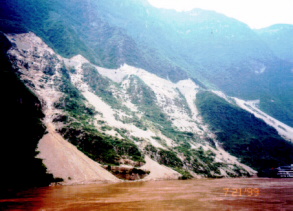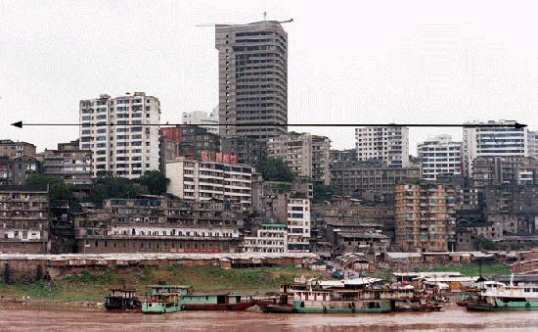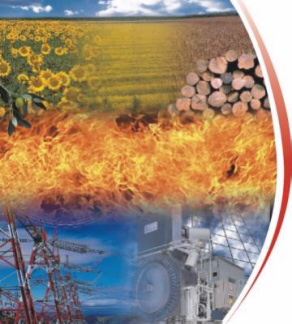|
* It is a hydroelectric dam that spans the Yangtze River in Sandouping, Yichang, Hubei, China.
* It 1.5 miles wide, 600 ft high and will create a reservoir of 400 miles long.
* It is the largest project undertaken in China since the construction of the Great Wall and Grand Canal.
History

|
| Flooding caused by the Yangtze River |
Sun Yat-sen first proposed the idea of a hydroelectric dam at Three Gorges in 1919. The project was delayed due to the Chinese
Civil War and Chinese-Japanese War. The project was not revived until the mid 1940s when communist leader Mao Zedong ordered
studies on damming the Yangtze River which produced devastating floods each year. In 1992 the Three Gorges Dam was approved
and construction did not begin until 1993. The total duration of construction was expected to last 17 years. The work is divided
into three stages: the dam itself, the hydropower stations and the navigation facilities.
Benefits of the Project
According to Chinese authorities there will be 4 major benefits
Flood control: The dam is expected to tame the Yangzi River whose floods have killed more than 1 million people in the
last 100 years. It will produce a flood control capacity of 22.15 billion cubic meters, protect 1,533,333 hectares of farmland
and aid the people and property of Changjiang.
Power Generation: The dam is seen as an important future source of energy for China's growing electrical consumption.
26 turbines are designed to produce more than 18,000 megawatts of electricity which comprises 1/9th of the nation's electrical
production.
Navigation: a 600 km long waterway from Yichang to Chongqing will enable 10,000 ton seafaring ships to sail directly into
China's interior for 6 months of the year. River transport will increase from 10 million to 50 million tons a year and costs
reduced by 35%.
Pollutant Emission Reduction-according to the National Development and Reform Commission in China the Three Gorges Dam
will reduce coal consumption by 31 million tons per year, thereby cutting the emission of 100 million tons of greenhouse gases,
1 million tons of sulfur dioxide, 370,000 tons of nitric oxide and 10,000 tons of carbon monoxide.
Political Issues
* Money that was supposed to cover moving expenses and compensation for lost land and construction for new homes are
much lower than the rate of fair compensation.
* Officials involved in resettlement programs have smuggled money and then resigned from office. This corruption has
left resettlement projects with insufficient funds to relocate the inhabitants of the Three Gorges area
* If China were to enter a war the dam would be a primary target. If the dam is destroyed millions of people living
near the river, as well as military headquarters will be in danger.
Environmental Concerns

Siltation:
* Causes an accumulation of muddy water behind the dam which disrupts navigation conciliations and elevates water
levels. Siltation aggravates more floods and destruction of viable land.
Erosion of the reservoir and downstream riverbanks cause landslides and threatens of the world's larges fisheries in the East
China Sea. An estimated 1 million tons of annual catches may be reduced because of the decline in fresh water and sediment
reaching the sea.
Species Disruption:
* Many species such as the Siberian Crane, Yangtze sturgeon, the Yangtze freshwater dolphin and several flora species
have been negatively impacted by the construction of the dam.
Earthquakes: The area is impacted by small earthquakes each year, ranging from 1-2 on the Richter scale. However once the
dam is completed earthquakes are expected to rise to a 5-6 on the Richter scale.
Social/Cultural concerns
Relocation: The dam will force morethan 100 towns to evacuate the area and relocate downstream. The government estimates 1.2
million people will be resettled. However corruption and poor construction have delayed new housing or resulted in sub-standard
buildings.
Employment after relocation:
* 40% of people living in the Three Gores area are farmers but only 60% of those farmers will receive land in compensation.
* The rest will be forced to find urban jobs and change their lifestyle.
* China's unemployment rate is so high that the likelihood of finding a permanent job is slim.

|
| One of the many cities that will be abandoned after the Three Gorges project is completed |
Work cited:
http://darwin.bio.uci.edu/~sustain/state/kmin.html
http://internationalrivers.org/en/china/three-gorges-dam
http://www.cnn.com/SPECIALS/1999/china.50/asian.superpower/three.gorges/
http://www.mtholyoke.edu/~kbstrand/pictures.html
|
